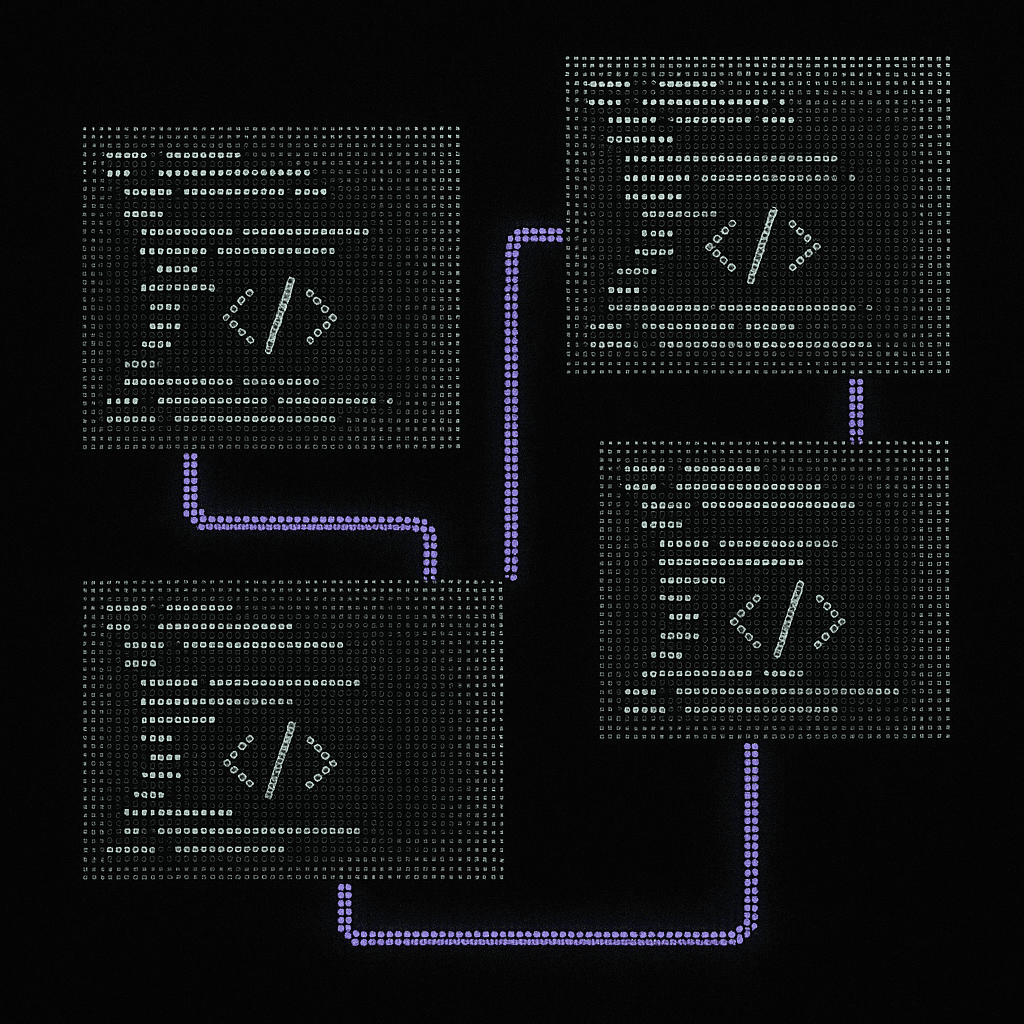
Why AI Code Reviews Prevent Production Outages
August 13, 2025
TL;DR: AI code reviews demonstrate measurable benefits for preventing production outages in complex systems with 40+ microservices, though implementation requires strategic approach as 2025 research shows initial setup periods involve learning curves before achieving 15-40% performance improvements in detecting architectural violations that human reviewers consistently miss.
-------
Picture this scenario. You make an eight-line change to a shared utility library. The tests pass. The code looks fine. Someone approves it in five minutes.
Two hours after deployment, your payment system dies. Then notifications stop working. Then the entire order pipeline collapses. This is exactly the scenario that modern AI code review systems are designed to prevent.
Research shows that systems without proper circuit breaker implementations experience complete failure cascades within seconds of an initial service failure, with diagnosis delays averaging multiple service hops due to observability gaps. But modern AI systems can instantly map these dependencies across your entire codebase, catching dangerous changes before they reach production.
The problem wasn't the code. It wasn't even the review process. The problem was expecting humans to hold an entire distributed system in their heads while looking at eight lines of diff.
Why Code Reviews Have Outgrown Human Cognition
Most people think code review is about catching bugs. It's not. It's about understanding systems.
When you're working on a simple Rails app with three developers, human review works fine. One person can understand the whole system. They know what connects to what. They can predict what might break.
But when you have dozens of services across hundreds of repositories, the math changes completely. No human can track all the relationships between microservices. The dependencies. The configurations. The deployment pipelines. The shared libraries.
Recent research from Springer Computing reveals that developers working across multiple microservices experience 25% higher organizational coupling compared to single-service contributors. This isn't a training problem or a process issue - it's a fundamental cognitive limitation that's now been quantified.
An IEEE Access study employed eye-tracking methodology to directly measure cognitive load during pull request workflows, documenting measurably higher strain as repository count increases. Research establishes that humans can track approximately three or four interdependent relationships simultaneously under optimal conditions.
According to a large-scale GitHub analysis published in the ACM Digital Library, internal cross-repository references are directly linked to increased review time, quantifying the coordination overhead in polyrepo environments through statistical correlation between cross-repo dependencies and extended review cycles.
This is where AI code review transforms the game. Instead of fighting human cognitive limitations, we can leverage AI systems that excel at exactly these complex relationship mappings.
The Cross-Repository Dependency Crisis
2025 research establishes a critical threshold: systems with 40+ services demonstrate measurable architectural drift without continuous governance. The Cloud Native Computing Foundation's 2024 Annual Survey found that 46% of organizations operate microservices architectures at production scale, with 29% deploying code multiple times per day.
This creates intensive coordination requirements that human reviewers cannot manage effectively, but AI systems handle naturally:
- Version conflict resolution complexity increases exponentially with repository count
- Dependency graph bottlenecks emerge when services require coordinated scaling
- Organizational coordination overhead grows non-linearly with the number of teams managing separate repositories
Here's something most people don't realize about microservices. They don't actually reduce complexity. They just move it around. Instead of one complicated application, you have twenty simple applications with complicated relationships.
The worst bugs aren't syntax errors or logic mistakes. They're architectural violations. Someone changes an API contract without updating all the clients. Someone removes a seemingly unused function that actually triggers a critical background job. Someone adds async code to a synchronous event handler and breaks message ordering.
These bugs slip through because no human reviewer can see the whole system at once. AI systems can.
How Context-Aware AI Systems Actually Work
The real power of AI code review isn't better linting or faster suggestions. It's scale and context.
2025 research published in Information and Software Technology analyzed 227 peer-reviewed studies and found graph-based AI models achieve 15-40% performance improvements over baseline approaches by addressing critical context window limitations of pure language model approaches.
An AI system can hold your entire codebase in its head simultaneously. All the repositories. All the dependencies. All the configuration files. All the deployment scripts. When you change something in one place, it can instantly see what else might break.
The breakthrough technology is the Code Property Graph (CPG) approach. According to USENIX Security 2025 research, hybrid CPG plus language model frameworks achieve:
- 15-40% improvement in F1-score for detecting breaking changes
- 67-93% code size reduction while preserving essential context
- Maintained performance under syntactic transformations
Instead of reading your code as text, the AI builds a graph of relationships. Function A calls function B. Service X depends on service Y. Database table Z is used by services P, Q, and R.
Research published on repository-scale context understanding shows the Code-Craft Hierarchical Code Graph Summarization framework achieved up to 82% relative improvement in top-1 retrieval precision for large repositories, evaluated across 5 codebases totaling 7,531 functions.
When you make a change, the AI walks the graph to see what else is affected, maintaining a comprehensive model of your entire codebase that never forgets anything and never gets tired.
Understanding AI Code Review Learning Curves
Here's where 2024-2025 research reveals important insights about implementing AI-assisted code review effectively.
AI code review requires an initial configuration period, but delivers superior architectural violation detection.
During the initial setup period, teams experience temporary increases in review time as AI systems learn architectural patterns. Peer-reviewed research analyzing 4,335 pull requests across 10 open-source projects found that unconfigured AI-assisted code review increased average PR closure time from 5 hours 52 minutes to 8 hours 20 minutes during the learning phase.
However, this initial investment pays dividends: AI systems detect architectural violations that human reviewers consistently miss. The additional time is spent on meaningful issues rather than archaeological research across repositories.
The longitudinal data reveals the importance of proper implementation. A difference-in-differences study tracking 807 repositories found initial productivity challenges completely resolve by month 3 with proper governance and configuration.
Microsoft's randomized trial analyzing 8,500 pull requests demonstrated that properly implemented AI-assisted review achieves a 60% reduction in PR resolution time while maintaining higher code quality compared to pure human review.
The key insight: initial slowdown occurs because AI systems surface critical issues that human reviewers often miss due to cognitive limitations. Organizations that invest in proper configuration see dramatic long-term improvements.
Human-AI Collaboration Models That Work
The pattern that works isn't AI replacement of humans - it's AI-first, human-second collaboration.
Research on hybrid intelligence frameworks identifies optimal task allocation:
AI capabilities optimally suited for:
- Repetitive pattern detection across repositories
- Large-scale dependency analysis and synthesis
- Consistency checking against architectural rules
- Cross-service impact analysis
Human capabilities that remain essential for:
- Strategic decision-making requiring business context
- Ethical considerations and trade-off judgments
- Novel problem-solving in ambiguous situations
- Stakeholder communication and change management
Here's what this looks like in practice. You open a pull request. The AI immediately identifies downstream services that will be affected if you merge this change, plus configuration files that need updating. You fix those issues before any human even looks at the code.
When a human reviewer finally sees your pull request, they're not doing dependency archaeology. They're asking better questions: Does this solve the right problem? Is there a simpler approach? Does this fit with our broader architecture goals?
Implementation Strategies for Enterprise Teams
If you're considering AI code review for a complex distributed system, here's what the research shows actually works:
Start with dependency-heavy repositories. The AI provides maximum value where human cognitive load is highest. Pick a shared library or service that frequently causes production incidents.
Configure for your specific patterns. According to 2025 DORA research surveying 5,000 software professionals, "AI acts as an amplifier of existing organizational strengths rather than a standalone productivity enhancer." The AI needs to learn your architectural conventions, naming patterns, and deployment practices.
Plan for a learning period. Research shows optimal results require a configuration and tuning period of approximately three months, with teams often surprised by how effectively AI can be tuned for their specific codebase once properly configured.
Focus on architectural violation detection. The highest-value AI capabilities are identifying breaking changes across repositories - architectural violations like distributed monoliths, shared database anti-patterns, API contract violations, and boundary erosion.
Why AI Code Reviews Are Essential for Modern Development
The evidence from 2024-2025 research points to a clear conclusion: AI code review becomes essential at enterprise scale where human review fundamentally fails.
For organizations operating systems with 40+ services, hundreds of repositories, and multiple deployment pipelines daily - AI assistance transitions from optimization to necessity. Research establishes that microservices systems demonstrate measurable architectural drift without continuous governance, with 25% higher organizational coupling when developers work across multiple services.
The alternative is what we observe at most enterprise companies: senior engineers spending significant time on review archaeology instead of building features, teams afraid to make changes because they can't predict cross-service impact, and production incidents that could have been prevented with better system-wide visibility.
The companies adopting AI code review first aren't doing it because it's trendy. They're doing it because the complexity of managing distributed systems has outgrown human cognitive capacity, and the potential cost of production outages far exceeds the overhead of more thorough automated review.
Related
- Autonomous Quality Gates: AI-Powered Code Review That Understands Enterprise Standards
- Context Engine vs Context Windows: Why Token Count Isn't Everything
- COD Model: 5-Phase Guide to Codebase Dependency Mapping
- Microservices Impact Analysis: AI-Powered Dependency Mapping
- Best AI Code Review Tools 2025
The future of software development isn't humans versus machines - it's humans and machines doing what they each do best. AI handles the systematic analysis that exceeds human cognitive capacity, while humans focus on strategic decisions that require business context and creative problem-solving.

Molisha Shah
GTM and Customer Champion